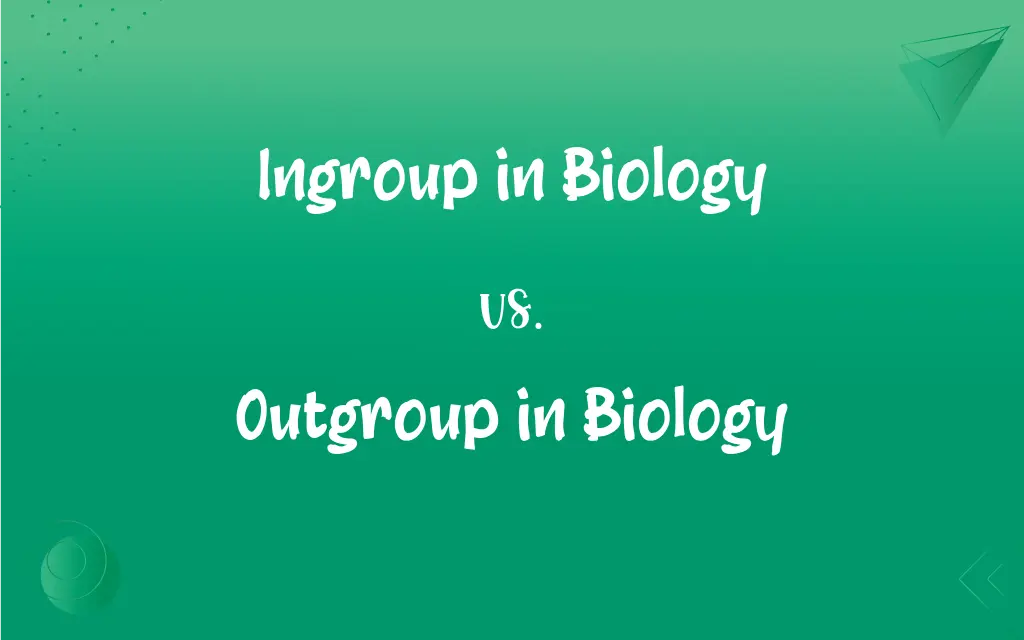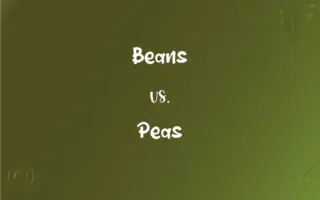Ingroup in Biology vs. Outgroup in Biology: What's the Difference?
Edited by Aimie Carlson || By Janet White || Published on June 28, 2024
Ingroup in biology refers to a group of organisms sharing key characteristics, studied for evolutionary relationships, whereas an outgroup is used as a reference point, lacking these shared traits, to understand evolutionary divergences.

Key Differences
Ingroup and outgroup are terms used in the study of evolutionary biology to understand phylogenetic relationships among organisms. The ingroup consists of the main subjects of study that share specific, common traits indicating a recent common ancestry. In contrast, the outgroup, which shares a more distant common ancestry with the ingroup, lacks these specific traits, providing a baseline for comparison.
When constructing a phylogenetic tree, the ingroup is the focus, as it helps scientists decipher the evolutionary path and relationships within a group of closely related organisms. The outgroup, on the other hand, serves to root the tree, offering a point of reference that helps identify derived traits present in the ingroup.
The selection of an appropriate outgroup is critical for accurate phylogenetic analysis. It must be closely related enough to the ingroup to be relevant, yet distinct enough to have diverged before the ingroup's defining traits evolved. This balance ensures the outgroup's effectiveness in highlighting the unique evolutionary features of the ingroup.
The use of ingroups and outgroups allows researchers to infer the ancestral states of traits within the ingroup. By comparing these groups, scientists can deduce which traits are ancestral (present in both ingroup and outgroup) and which are derived (present only in the ingroup), thus reconstructing the evolutionary history of the ingroup.
This methodology underscores the importance of comparative analysis in evolutionary biology. By examining the differences and similarities between the ingroup and outgroup, biologists can trace the lineage of organisms, understand how traits evolved, and elucidate the broader patterns of life's history on Earth.
ADVERTISEMENT
Comparison Chart
Definition
Group of organisms under study sharing specific traits.
Reference group lacking specific traits of the ingroup, used for comparison.
Role in Phylogenetics
Central to understanding evolutionary relationships among closely related species.
Serves as a baseline to identify derived traits in the ingroup.
Selection Criteria
Must share recent common ancestry and specific traits.
Must be closely related but distinct enough to have diverged before ingroup traits evolved.
Contribution to Analysis
Helps in reconstructing evolutionary pathways within the group.
Enables the determination of ancestral and derived traits.
Impact on Phylogenetic Tree
Focus of the tree, representing closely related species.
Roots the tree, providing a point of reference for comparison.
ADVERTISEMENT
Ingroup in Biology and Outgroup in Biology Definitions
Ingroup in Biology
Defined by common ancestry.
The ingroup shares a recent common ancestor, distinguishing them from other species.
Outgroup in Biology
Lacks specific traits of the study group.
The outgroup diverged before the development of mammalian characteristics.
Ingroup in Biology
The focus of phylogenetic analysis.
The ingroup reveals how specific traits have evolved over time.
Outgroup in Biology
Provides a baseline for comparison.
Using an outgroup helps identify which traits are derived in the ingroup.
Ingroup in Biology
Central to comparative biology.
Comparing ingroup members helps understand biological diversity.
Outgroup in Biology
A reference organism in phylogenetic studies.
The lizard serves as an outgroup in the study of mammalian evolution.
Ingroup in Biology
A group of organisms studied for shared evolutionary traits.
In studying primates, humans and apes constitute the ingroup.
Outgroup in Biology
Critical for rooting phylogenetic trees.
Selecting an appropriate outgroup is essential for accurate tree construction.
Ingroup in Biology
Used to trace evolutionary relationships.
By examining the ingroup, scientists can map out the tree of life.
Outgroup in Biology
Helps in determining ancestral states.
The outgroup's traits offer clues to the ancestral form of the ingroup.
FAQs
What is an outgroup in biology?
An outgroup in biology is a reference group used in evolutionary studies that lacks the specific traits of the ingroup, providing a baseline for comparison.
How is an outgroup selected in phylogenetic studies?
An outgroup is selected based on its close but distinct relationship to the ingroup, ensuring it diverged before the ingroup's defining traits evolved.
Why are ingroups and outgroups important in evolutionary biology?
They are crucial for understanding evolutionary relationships, determining ancestral and derived traits, and constructing accurate phylogenetic trees.
What is an ingroup in biology?
An ingroup in biology refers to a group of organisms being studied that share specific, common traits indicating a recent common ancestry.
Can the outgroup share any traits with the ingroup?
Yes, but these traits are generally more ancestral and not the specific derived traits defining the ingroup's recent evolutionary history.
How do ingroups and outgroups contribute to constructing phylogenetic trees?
Ingroups are the focus, showing relationships and trait evolution, while outgroups provide a reference point, helping to root the tree and distinguish derived traits.
Are ingroups and outgroups fixed categories?
No, the classification as ingroup or outgroup is relative to the focus of the study and can change as the scope of research shifts.
Can there be more than one outgroup in a study?
Yes, using multiple outgroups can provide a more robust comparative analysis and help ensure the accuracy of phylogenetic reconstructions.
What happens if the wrong outgroup is chosen?
Choosing the wrong outgroup can lead to incorrect assumptions about ancestral and derived traits, potentially misleading the evolutionary history interpretation.
What criteria define an ingroup?
An ingroup is defined by sharing specific traits indicative of a recent common ancestry, distinguishing it from more distantly related organisms.
How do researchers ensure that an outgroup is appropriately related to the ingroup?
Researchers review evolutionary histories, genetic data, and morphological characteristics to ensure the outgroup diverged just before the ingroup's defining traits evolved, ensuring relevance without being too closely related.
What challenges are involved in selecting an outgroup?
Challenges include finding a balance where the outgroup is closely related enough to be relevant but not so close as to share the ingroup's derived traits, requiring careful consideration of evolutionary history and traits.
How does the concept of ingroups and outgroups help in evolutionary biology?
It aids in deciphering the evolutionary history and relationships among organisms by providing a framework for comparative analysis and trait evolution understanding.
Can the same species be an outgroup in one study and an ingroup in another?
Yes, depending on the research focus and the traits under investigation, a species can serve as an outgroup in one context and an ingroup in another.
How does the use of molecular data influence the selection of ingroups and outgroups?
Molecular data, including DNA and protein sequences, provides detailed insights into genetic relationships and evolutionary distances, refining the selection process for ingroups and outgroups based on genetic similarity and divergence.
What impact do ingroups and outgroups have on understanding biodiversity?
By comparing ingroups and outgroups, scientists gain insights into the diversity of life, evolutionary mechanisms, and how different species have adapted over time, enhancing our understanding of biodiversity.
Why is it important to study both ingroups and outgroups in evolutionary research?
Studying both ingroups and outgroups provides a comprehensive view of evolutionary relationships, enabling scientists to reconstruct ancestral traits, understand speciation events, and clarify the evolutionary history of life on Earth.
What role does phylogenetic context play in determining ingroups and outgroups?
Phylogenetic context determines the evolutionary relationships and historical divergences, guiding the selection of appropriate ingroups and outgroups for comparative studies.
What is the significance of derived traits in identifying ingroups?
Derived traits are crucial for identifying ingroups as they represent evolutionary novelties that distinguish the ingroup from the outgroup and help in understanding the evolutionary paths taken by the ingroup.
How does the selection of an outgroup affect phylogenetic analysis?
The selection of an outgroup critically affects the analysis by providing a point of comparison for determining which traits are ancestral and which are derived, influencing the interpretation of the evolutionary history of the ingroup.
About Author
Written by
Janet WhiteJanet White has been an esteemed writer and blogger for Difference Wiki. Holding a Master's degree in Science and Medical Journalism from the prestigious Boston University, she has consistently demonstrated her expertise and passion for her field. When she's not immersed in her work, Janet relishes her time exercising, delving into a good book, and cherishing moments with friends and family.
Edited by
Aimie CarlsonAimie Carlson, holding a master's degree in English literature, is a fervent English language enthusiast. She lends her writing talents to Difference Wiki, a prominent website that specializes in comparisons, offering readers insightful analyses that both captivate and inform.








































































